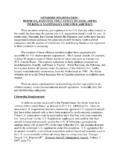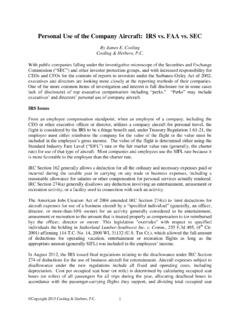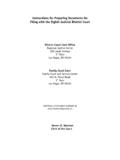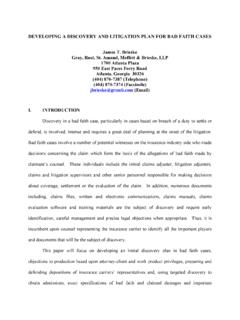Transcription of Paul V. Herbers - coolinglaw.com
1 DEFENSE PLANNING FOR THE WRONGFUL DEATH CASE paul V. Herbers III. DEFENSE PLANNING FOR THE WRONGFUL DEATH CASE The following discussion is not intended to be exhaustive, rather it is intentionally selective, to address many of the common issues confronted in the wrongful death case, while at the same time assuming a general understanding of these procedures by the reader. The best general reference is the MoBarCLE series, in the following three volumes: Tort Law II, ch. 27, Wrongful Death; Damages, ch. 17, Wrongful Death; Litigation Settlements, ch. 5, Wrongful Death. A. What to Include in the Case Investigation Often the defense of a wrongful death case will begin before the plaintiffs have found an attorney. Normally, there will be more than one plaintiff, being the members of the decedent's family, although all plaintiffs together will be pursuing the same wrongful death claim.
2 Depending on the choice of law issues which may arise, and questions' as to which state's wrongful death statute applies, this group of plaintiffs can vary, so that often there is confusion in the early stages as to who the proper plaintiffs are, and as to who most properly will represent the group. The-potential defendants usually know who they are, and they will either have insurance or be a large enough company, with assets worth pursuing, so that an initial investigation has already begun. In many cases, defense counsel may have already been consulted long before the plaintiffs have presented a claim. In some cases, however, such as for component manufacturers of a product which is the alleged defective cause of the death, the first notice of the incident at all is the defendant's receipt of the summons and petition.
3 The primary source of information for the defense counsel is the client, and any related employees and documents. In a medical malpractice case, the defendant may be able to secure cooperation from hospital employees or other personnel. In a products liability case, the defendant may be able to consult component vendors or customers. Several personal visits with the client may be necessary at the very outset of the case, and counsel should not be shy in asking for the client's help. In addition, sources to be gathered in the investigation of a death case will include all the following items: 1. The autopsy, an interview with the coroner, and if cause of death or time of death is in issue, perhaps the services of a pathologist.
4 2. Medical records of the decedent from the time of the incident up to death [including workers' compensation files]. 3. When relevant, medical records of the decedent before the incident. 4. Governmental investigation reports, police reports, emergency response team reports [fire department, ambulance, HAZMAT, etc], and personal interviews with all official personnel involved, most of whom are usually willing to talk off the record. 5. Interviews of all eyewitnesses, and when possible, video statements. An early video of an eyewitness at the scene, to point out when and how the accident happened, can be invaluable years later at trial. Take your camcorder with you on all interviews. 6. Collection of photo's, aerial photo's, charts and maps, weather records, and news reports.
5 7. Preservation of the accident vehicle or product, or instrument, or proper demand upon the custodian to prevent spoliation. 8. Review of insurance adjuster's report and interview with adjuster. [Note, this report is privileged under Missouri's insurer-insured doctrine, but the privilege is not recognized in Kansas or Illinois.] 9. Consultation with possible friendly co-defendants. 10. Collection of work records or time records of defendant's employees or others involved. 11. Obituaries. 12. The defendant's available insurance coverage. 13. The Internet. 14. Federal records, via Freedom of Information Act, applicable regulations, and industry standards such as ASME, ANSI, etc. In many death cases, defense counsel may find much of this information already collected in the insurer's claim file.
6 Nonetheless, the defense counsel should go beyond the file material as soon as possible, and do such things as establish personal contact with witnesses, make a personal visit to the scene, or conduct a personal examination of the "defective" product. B. Defense and Other Pleadings The form of the answer to the petition is rather routine and nontechnical, although defense counsel must be careful to address specifically each of plaintiffs allegations and not rely upon a general denial. governs the form of denials, and states , among other things, that: "If the responding party is without knowledge or information sufficient to form a belief as to the truth of a specific averment, the party shall so state, and this has the effect of a denial.
7 " Counsel should be aware that as to plaintiffs capacity to sue, which is often an issue in wrongful death cases among alleged co-plaintiffs, requires a denial of capacity to be specific and supported by known facts. See Fox Plumbing v. Kootman, 21076 ( Oct. 1997). Certainly, all known affirmative defenses need to be pleaded, and these include contribution or indemnity as to other alleged tortfeasors. Mitigation of damages may be a valid issue, even in a wrongful death case, as to certain members of the plaintiffs' group. Also, mitigating circumstances can be pleaded separately as recognized in the Wrongful Death Statute. See generally as to affirmative defenses. If another state is involved, don't forget about statutes of repose and ceilings on nonpecuniary damages.
8 Frivolous affirmative defenses should be left -out, but only if counsel is certain no evidence will likely be discovered later. For example, if defendant's car rear-ended the car of plaintiffs decedent while sitting at a red light, and the defendant in counsel's first interview offers no opinion that plaintiffs decedent did anything questionable, then an affirmative defense of comparative fault is frivolous. Inconsistent pleadings stated in the alternative are, of course, appropriate, under , although at trial only consistent theories may be submitted in the jury instructions. Defense counsel should also be alert as to , which requires plaintiff to file a reply pleading, if plaintiff seeks to avoid an affirmative defense.
9 Angoff v. Mersman, 917 S. 207( 1996). Clearly, in the first 30 days of a case, counsel only knows a little of the evidence compared to months later when discovery is in full swing, and leave to file an amendment to add later-discovered affirmative defenses will be freely granted unless discovery has closed or trial is imminent. A cross claim against a codefendant for contribution and indemnity is not essential to support submission of the jury instruction on allocation of fault, but it may prove necessary post-judgment if plaintiff executes disproportionately against one defendant, who wants to recover the excess from another. C. Discovery Techniques In federal court, discovery will begin with Rule 26 compliance. In state court, local rules may restrict interrogatories.
10 Interrogatories are of very limited value. They are helpful to identify potential plaintiffs, witnesses and documents, to list special damages, and to secure authorizations for the decedent's medical, and employment and tax records. Beyond that, however, interrogatory answers are usually crafted by plaintiff s counsel to be useless. This is not to suggest that defense counsel skip them, but simply realize the limitations. Also, contention interrogatories, which might seem useful to ferret out plaintiffs theories, usually don't help much. Often the trial court will, upon objection, permit plaintiff s counsel to delay a response to contention interrogatories until discovery is complete, by which time the experts will be deposed anyway.









